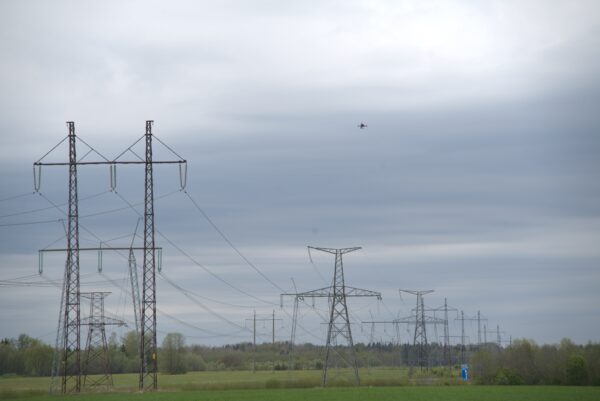As the electricity consumption keeps growing in Latvia, so does the need for a stable and reliable electrical grid. To minimize the risk of possible power outages, power line defects have to be detected before they become dangerous. That is why Latvia’s leading distribution system operator Sadales tīkls has been testing drone technology and its use with their inspection teams.

Hepta power line inspection in process
Sadales tīkls covers 99% of the whole territory of Latvia with its network and has set the secure and continuous electricity supply as their top priority. To ensure this, they have been actively testing innovative technologies to see what could be introduced to their everyday operations. That is also what brought them to drones. Sadales tīkls inspection teams in Dobele region were equipped with drones, taught how to fly them effectively and how to take photos of power lines with them. Until now power line inspections have been done by on-foot patrols, but they are quite demanding for the inspectors and sometimes error-prone. Equipping the inspection teams with drones enables them to get a closer, detailed look at the power poles, something that is hard to achieve from the ground. Most of the defects that affect the power lines are situated at the top of the poles and are sometimes hard to see from below. Power lines also tend to go over all types of terrain, some of which is quite hard to traverse for the inspection teams, such as marshes or larger rivers. Fortunately, drones are almost always unaffected by the terrain, allowing the inspectors to avoid unwanted swims to check the power poles.
Once all the needed data of the power lines was captured, it was analyzed by Sadales tīkls in a special inspection platform called Hepta Insights, which enabled for quick detection of defects. “Before we started these tests, it seemed that it would be a very complicated platform to do our inspections in, but I was rather amazed at its simplicity and intuitive operations. After a few minutes of learning, we were able to navigate relatively freely in a program that does such a filigree job of analyzing the photos,” commented Sadales tīkls master Edgars Juka.
While Sadales tīkls is still evaluating the tests and planning the next steps, the early results have been positive. Combining experienced inspectors with nimble drones and capable software can help to speed up the process. “We regularly evaluate the company’s business processes, looking for new technological opportunities to make them more efficient, and testing new solutions helps us find the most appropriate technologies to achieve the desired result. Drones allow for a quick and close overhead power line inspection and detailed inspection of each grid element. In turn, the data processing software must effectively analyze the condition of power lines, allowing to quickly identify the defects that can be corrected before they affect the quality of the power supply. We will summarize and carefully evaluate the results of this pilot project to decide in the future how meaningful and reasonable it would be to implement the specific solution in the company’s daily operations.” says Jānis Kirkovalds, Member of the Board and Development Director of Sadales tīkls.
The drone technology and inspection platform Hepta Insights used in the tests were provided by the technology company Hepta. Elviss Straupenieks, the VP of SaaS at Hepta commented on Sadales tīkls performance: “It is always a pleasure to work with a company that is open to new and innovative solutions. By using drones for fault detection, Sadales tīkls will be able to respond in a timely manner to faults in the grid. It will promote the use of more efficient tools for power line inspection in Latvia and overall improve the safety and reliability of the grid.”
About Sadales tīkls: Sadales tīkls AS is Latvia’s electricity distribution system operator. It ensures power supply to nearly one million clients, with its services covering 98% of the country’s territory. The total length of the distribution networks was 92 656 kilometres in 2020 and this is twice as long as the circumference of the Earth along the Equator.


